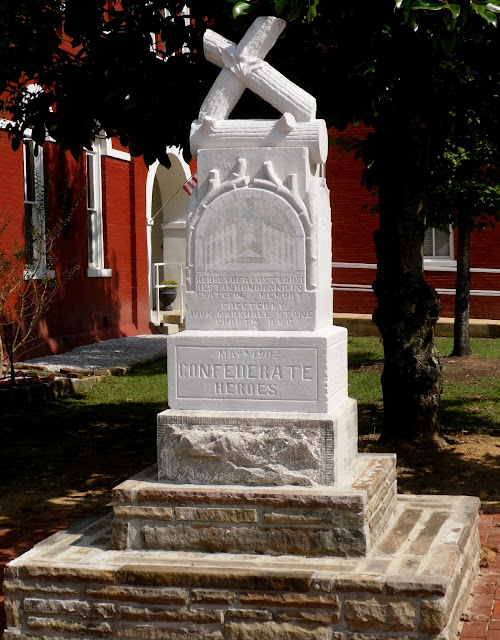Copyright © 2012 Bob R Bogle
Some days pictures are primarily aesthetic; some days they are primarily informational. This day was the latter kind of day. Most of the pictures here have been corrected accordingly to optimize their legibility.
Brices Crossroads. This battle site northwest of Tupelo was far more interesting than I expected it to be. The federal commanding officer Samuel D Sturgis put in a poor performance and was thoroughly defeated here by Bedford Forrest. Nevertheless, this is one of the more important Pyrrhic victories of the Civil War, because Forrest was drawn to the west to engage Sturgis rather than to the northeast, where he could have done much more serious damage to Sherman's supply lines as he was in the early stages of his campaign against Atlanta.
You might notice that the design of the following monument and signage are the same as at the Tupelo Battlefield site. Or you might not. This ground of this entire battlefield, including the cemetery, are absolutely rotten with fire ants.
One of those relatively rare confederate cemeteries.
Back on the Natchez Trace:
On to Iuka and Corinth. Battles in these towns were waged by some of the most obnoxious bunglers on both sides of the conflict. For the north we had William S Rosecrans, and for the south we had Sterling Price and Earl Van Dorn.
In the Battle of Iuka, Price was lucky to escape because of Rosecrans' errors, as well as by virtue of acoustic shadowing. It's almost possible to feel sorry for Price here, because he was being torn by conflicting orders from Braxton Bragg, who was struggling in his own problematic way to save the confederacy, and Earl Van Dorn, who was struggling to inflate his own bouffant reputation. Unfortunately, very little history has been preserved in the modern town: the main part of the battlefield is now a highway interchange. The woman at the courthouse whom I tried to speak to about it told me it's her policy to leave the dead alone.
National Park Service interpretive center for Corinth. My pictures completely fail to do it justice, but the information they contain may be (somewhat) useful.
This is a lousy map, but it does contain, at a glance, the important sites mentioned in the previous graphics.
A nice and well-known sculpture/display located outside; again, my pictures don't really convey the effect.
Some days pictures are primarily aesthetic; some days they are primarily informational. This day was the latter kind of day. Most of the pictures here have been corrected accordingly to optimize their legibility.
Brices Crossroads. This battle site northwest of Tupelo was far more interesting than I expected it to be. The federal commanding officer Samuel D Sturgis put in a poor performance and was thoroughly defeated here by Bedford Forrest. Nevertheless, this is one of the more important Pyrrhic victories of the Civil War, because Forrest was drawn to the west to engage Sturgis rather than to the northeast, where he could have done much more serious damage to Sherman's supply lines as he was in the early stages of his campaign against Atlanta.
You might notice that the design of the following monument and signage are the same as at the Tupelo Battlefield site. Or you might not. This ground of this entire battlefield, including the cemetery, are absolutely rotten with fire ants.
One of those relatively rare confederate cemeteries.
Lots of these fellows around.
Back on the Natchez Trace:
In the Battle of Iuka, Price was lucky to escape because of Rosecrans' errors, as well as by virtue of acoustic shadowing. It's almost possible to feel sorry for Price here, because he was being torn by conflicting orders from Braxton Bragg, who was struggling in his own problematic way to save the confederacy, and Earl Van Dorn, who was struggling to inflate his own bouffant reputation. Unfortunately, very little history has been preserved in the modern town: the main part of the battlefield is now a highway interchange. The woman at the courthouse whom I tried to speak to about it told me it's her policy to leave the dead alone.
And so we proceed to Corinth. Two different "battles" took place here: the first (the so-called Siege of Corinth) was the timid creep by Henry Halleck to capture the vital railroad crossroads after Grant's reputation was temporarily impugned in the wake of Shiloh. The more interesting clash (Second Corinth) took place after Iuka, when Price and Van Dorn had consolidated their forces and again clashed with Rosecrans. Again, with little thanks to Rosecrans, both Price and Van Dorn were lucky to escape (although by this point Van Dorn's days were numbered). And again, battlefield preservation is not so good, but the National Park Service interpretive center for Corinth, as part of the Shiloh National Military Park up the road in Tennessee, is quite nicely done.
The Historic Corinth Depot and Crossroads Museum is a sort of catch-all Corinth museum that was rather a disappointment.
National Park Service interpretive center for Corinth. My pictures completely fail to do it justice, but the information they contain may be (somewhat) useful.
This is a lousy map, but it does contain, at a glance, the important sites mentioned in the previous graphics.
A nice and well-known sculpture/display located outside; again, my pictures don't really convey the effect.
I got to Oxford quite late, having had to alter my itinerary rather considerably on the fly.
Then it was a drive through a dark, moonless night to Memphis.














































No comments:
Post a Comment
Comment? Criticism? Insight? Rant? Do it here.